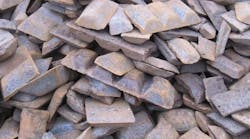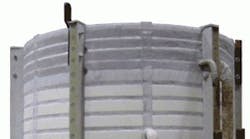Three things will prolong the life of an induction furnace coil significantly and minimize furnace downtime:
• Buy the best melting equipment available for your application;
• Select a proper refractory, install and sinter it carefully; and,
• Schedule regular furnace and refractory maintenance, and perform it rigorously.
Gary Stevers, president of Metaltec Steel Abrasive Co., offered that advice some years ago and continues to benefit from it. A furnace installed at Metaltec in 1998 has produced more than 182,500 metric tons of molten steel without needing a coil change or even a coil repair. It’s the same with Metaltec’s two other furnaces: one has been operating trouble-free for 12 years, pouring 167,825 metric tons of steel; and the newer one has been running for seven years, pouring 65,633 metric tons of steel without unscheduled downtime.
Metaltec, which produces low-carbon bainite steel shot in Canton, MI, operates three 5,000 kW Inductotherm six-ton heavy steel shell furnaces, each with vibrating pivot-charging conveyors. Every week, Metaltec runs two eight-hour shifts and often operates through weekends with two 12-hour shifts each day. On average Metaltec produces 170 metric tons of shot per day.
Each heat is processed in the furnace for 42 minutes at temperatures reaching 3,100°F and is poured immediately to produce shot. Pouring takes 24 minutes. “We are a busy shop and I don’t want to spend time or money on repairing or replacing furnace coils,” according to Stevers. “Coils are capital equipment, not consumable items. That’s why Metaltec bought the most rugged and dependable induction furnaces available.”
In particular, Stevers cited the furnace coil’s heavy copper tubing, durable Inducto-Flex® coil insulation and the strong furnace structure. “The heavy copper tubing is locked into position by the rigid coil supports and surrounding furnace steel shell,” he explained. “This keeps the coil from flexing and losing its shape. Also, the tough insulating coating on the coil helps to protect it against arcing. I’ve always had excellent service life from Inductotherm coils and the new Inducto-Flex insulation has enhanced their trouble-free operation.”
“When you start with the best furnaces, you need to keep them in shape by providing the best lining material for your application, installing that refractory properly and sintering it according to specification, no shortcuts,” he continued. “At Metaltec we use a proper lining form vibrator system to compact the refractory material completely and to ensure there are no voids. This works very well for us, and I can be sure the same results are achieved no matter who installs the lining.”
To be certain each lining is brought on-line properly and not hurried, Stevers said he handles the sintering of every lining personally. “With our current lining material, the sinter rate is 400°F per hour,” he explains. “We use the Melt-Manager ® computer control system built into the power supply for this process. It enables us to precisely follow the best sintering profile. We also use three locations for the thermocouple readings. As the process starts, the lowest thermocouple is used to monitor and control the sinter heat.
“Once this thermocouple melts,” Stevers continues, “we move up to the center thermocouple and use this until it melts, too. The third thermocouple location is on the lining form adjacent to the upper cooling section of the furnace coil, which is monitored by a handheld temperature readout to ensure that we get the upper material hot enough to cure, since there is a lot of cooling in this area,” Stevers said. “We end up with a perfect, on-spec sinter.”
To avoid lining problems caused by thermal shock, Metaltec preheats the lining carefully each day. “The furnace is filled with charge materials to about the three-quarters full level and placed on idle for about two hours prior to the shift starting time,” Stevers explained. “At the start of the shift, the furnace is hot and ready for full power.”
Daily furnace and lining maintenance is the third requirement for ensuring long coil life.
“We perform a visual inspection of every furnace at the beginning of each shift,” reported Stevers. “We tighten the tie rods as often as needed or if the inspection indicates that they may need to be tightened. The major thing we look for during daily inspection is any difference in the top cap that would indicate that a tie rod had come loose or had broken. We have found that if the top cast ring is held in place, the coil tends not to grow and affect the integrity of the coil.”
He also said the shunt bolts are checked and tightened if a significant change in the furnace sound is apparent.
Regarding hoses and clamps, Stevers said, “We go over the hoses and connections only twice a year, during our shutdown times. We found that more frequent inspections were just not worth the time we were spending on them. We never seemed to have many issues with the hoses. They either leaked from the start or they didn’t leak at all,” he observes.
“About once a week, our inspections show us that we need to patch the furnace lining,” Stevers said. “Areas of wear are patched with an 85% alumina, plastic patch material. We patch the spout about twice a week. The bottom of the spout area is built up again to replace the worn area caused by our extended pour times,” he explained.
“Due to the rigidity and strength of our furnace coil and our daily maintenance on the furnace and its refractories, we average 145 heats per lining,” Stevers said. “That’s a good result for steel at 3,100°F.
“We regularly monitor lining wear, both by visual inspections and direct measurements,” he explained. “We can tell if it is wearing evenly or if the wear is more to one side. Typically, a lining is replaced simply as the result of normal wear.”
Metaltec’s furnaces are equipped with automated lining push-out systems. These speed the lining replacement process and minimize damage to the coil grout, according to Stevers. “In using these systems, the top cap and spout area material are removed and the lining refractory is cut out to just below the top cooling coil section of the furnace. Then, the rest of the refractory lining is pushed out with the pusher block. Once the lining is about three-quarters of the way out of the furnace, a wire rope sling is attached to the lining section and it is lifted the rest of the way out of the furnace.
“As a result of our regular maintenance and automated lining removal systems, overall downtime on our furnaces is well under 1%,” Stevers reported. “Altogether, Metaltec has produced more than 416,000 metric tons of steel shot using its original Inductotherm coils.”
“We have had over 72,000 combined heats on these furnaces with the original coils,” he added for emphasis. “That represents about $135 million of product, and those coils are still performing like new.”
Michael H. Nutt, Jr. is a district manager with Inductotherm Corp. Visit www.inductotherm.com









